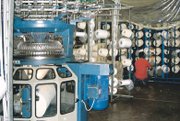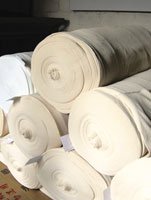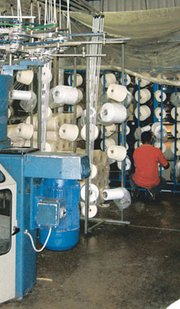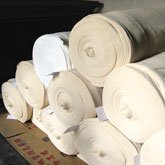Apparel Producers in Guatemala Getting Back on Track
GUATEMALA CITY—Inside the cinderblock walls of the Los Volcanes knitting mill, located just outside of Guatemala City, the rows of metal machinery are old, but the ownership is new.
In 2008, the mill was called Supratex until a local bank took it over to pay off the company’s debts. The massive machines that turn yarn into fiber stood dormant for nine months until a company called Los Volcanes Group bought the plant at a 60 percent discount and revved up production last fall.
In many ways, Los Volcanes epitomizes the ebb and flow of the Guatemalan apparel and textile industry during the last two years.
With more than 90 percent of its apparel exports going to the United States, Guatemala was hard hit by the U.S. economic recession. After consumers curtailed spending, the Central American country’s apparel exports to the United States declined 21 percent to $1.1 billion in 2009.
But times have changed. Textile mills are booked up to at least May or June, and apparel makers are breathing a sigh of relief. “Better winds are blowing this year,” said Carlos Amador, president of Agexport, the Guatemalan Association of Exporters.
That was evident during the three-day run of the March 23–25 Apparel Sourcing Show at the Grand Tikal Futura Hotel & Convention Center. This year 179 booths were set up by primarily Guatemalan manufacturers and their U.S. suppliers, compared with 160 last year.
Liztex Industries, the largest textile mill in Central America, was booked solid through June after seeing orders dip during the first three quarters of 2009, said Saul Mishaan, the company’s export manager. The mill’s largest customer is Van Heusen.
The same was true at Hilos y Telas, a long-time textile mill in Guatemala City that sells its woven and knit fabric to apparel makers in Central America and Mexico. “Last year was a tough year, and we were struggling all year long,” said Debora Suchite, an assistant merchandiser. “But at the end of last year, we started to see a recovery.” She predicts the mill’s fabric production will jump 20 percent to 30 percent this year.
Maybe the most telling indicator of the apparel industry’s future is at the country’s largest blue-jeans manufacturer, Denimatrix. Last year the factory, previously operating under the name Koramsa, closed its doors and laid off thousands of workers. After being resuscitated by a group of Texas cotton farmers known as the Plains Cotton Cooperative Association, the new U.S. owners set out to ramp up production as quickly as possible.
Last May, the factory was making 50,000 pairs of blue jeans a week. Now, the facility is producing up to 150,000 pairs a week with more to come.
“We’ve decided to invest a little more to grow the company by 35 percent by the first quarter of 2011,” said Denimatrix President Carlos Arias, who was president of Koramsa when it employed around 19,000 workers and made 700,000 pairs of blue jeans a week. Today, Denimatrix has 5,700 employees.
Many of the labels the factory works for are based in Los Angeles, such as Rock & Republic, Guess and Lucky Brand Jeans, as well as national brands Hollister, Gap Inc. and The Buckle. With Los Angeles seen as a profitable market, Denimatrix is planning to open a Los Angeles–area office at the end of April to capture more West Coast business.More service, more business
Guatemala and other Central American factories have always used their proximity to the U.S. market to capitalize on speed to market. They also have an advantage because most of their apparel and textile goods enter duty-free under the Dominican Republic–Central American Free Trade Agreement, which took effect in 2006.
But this year, there seemed to be more emphasis on full-package production and value-added services.
That was the reasoning behind Los Volcanes Group buying a shuttered textile factory. About 40 percent of the knit fabric from its newly acquired mill is being sent to the group’s cut-and-sew sister venture, known as Custom Made Services. The rest is sold to other Central American factories.
Having its own textile mill producing 110,000 pounds of fabric a month, a figure that should more than double by the end of the year, cuts down on cost and time.
“We used to buy fabric from other textile mills, and sometimes we had to pay 50 percent in advance. So it was a hard time,” said Erick Sterkel, the group’s president.
Being vertical helps one of Los Volcanes Group’s principal customers, Teamwork Athletic Apparel, a San Marcos, Calif., company that does in-stock and custom-made sports uniforms. Teamwork advertises it can fill a team’s uniform orders within seven days.
Other companies making new investments in Guatemala include the South Korean apparel giant Sae-A International, which has six factories with 6,600 workers around Guatemala City as well as 45 subcontractors. Revenues in 2009 dipped slightly to $281.8 million, from $294.1 million in 2008, said Mina Lee, a Sae-A representative. But that didn’t stop the corporation from building a new screen-printing and sublimation facility, called Glovia, to cater to the T-shirt trends in the United States. “What is in right now are graphic tees,” Lee said, noting that Sae-A’s main customers are Target Inc. and Wal-Mart Stores Inc. “Our production is up, and we should reach $300 million this year.”
While Sae-A is going for expanded printing capabilities, INT Trading is seeking higher-end T-shirt customers such as James Perse, Guess and Lucky Brand Jeans while also doing production for Kohl’s.
“We are getting more clients and pursuing higher-end brands,” said D.Y. Kim, president of the company he bought eight years ago. He said his revenues tumbled from $40 million in 2008 to $30 million in 2009, but he expects to be back to his 2008 numbers this year.
Better service and full-package capability is what prompted Accesorios Textiles to expand its label-making capabilities by adding hangtags, industrial embroidery, price tickets and heat transfer to its repertoire of offerings, said Sergio De La Torre, the company’s president.
That was prompted by an economic misfortune. In 2008, Accesorios lost its only customer, Avery Dennison Corp., after the Pasadena, Calif.–based label maker acquired Paxar Corp.
Previously, Accesorios produced only woven labels exclusively for Avery Dennison. It revamped its business plan and moved to the Denimatrix campus to supply hangtags, price tags and labels for the blue-jeans market. “We can now do quick-turn response, which is being asked for,” De La Torre said.
Quick-turn response is what attracted Rich Campanelli to the Apparel Sourcing Show. His company, Fine Apparel Manufacturer in Commerce, Calif., makes activewear, sportswear, T-shirts and other apparel for such labels as Laura Ashley, Bongo, Bally Total Fitness and Simply Organic. It also acquired Marika, a San Diego yoga and fitnesswear company, in 2008 from The CIT Group. Marika is now its fastest-growing unit.
This was Campanelli’s first trip to the Apparel Sourcing Show, said the director of sourcing. In the past, his company has done all its sourcing in China and Bangladesh. But now they want to change that mix, especially for higher-duty items such as synthetic tops and bottoms. “We are down here to look at how we can bring product to market faster,” he said. “I think there is some potential out of here.”

























